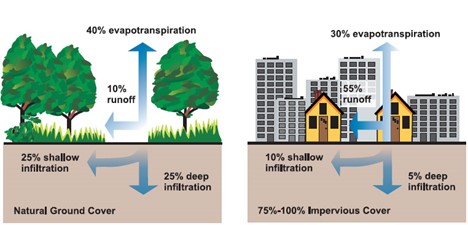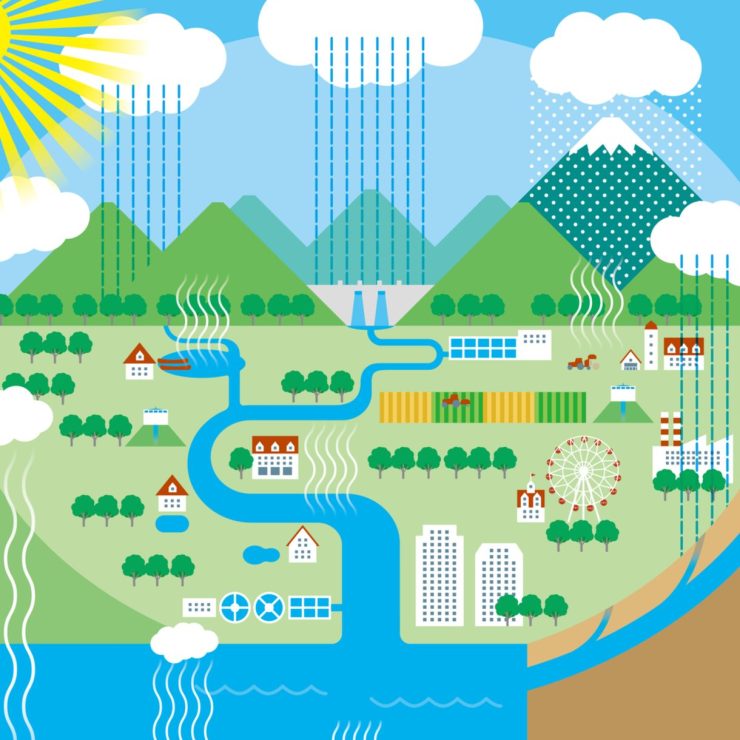By: James Wade, PE
The adage “Dilution is the solution to pollution” may have worked historically, when population and development densities were low. However, these days it is just wrong. The wisest option is prevention – keep the pollutants out of the water. To this end, sections of the Clean Water Act of 1972 established regulation of pollutant discharges, including pollutants borne by stormwater runoff, into the waters of the United States and established water quality standards for receiving surface waters.
The typical change in the water cycle when a watershed is developed is shown in the figure below. A change to the watershed landscape changes how water, and the pollution water carries, transports through the watershed. Preventing “clean” water from becoming “dirty” is one of the central tenets of regulating stormwater discharges under the Clean Water Act.

Under the law, overall enforcement of the Clean Water Act was assigned to the United States Environmental Protection Agency (USEPA), who then delegated authority to states with approved permitting and enforcement programs. The Maryland Department of the Environment develops regulations to implement the Clean Water Act and other federal and state environmental laws..
After twenty five years of failed voluntary agreements among the states to improve water quality conditions in the Chesapeake Bay, the USEPA developed a Total Maximum Daily Load (TMDL) for pollutants nitrogen, phosphorus, and sediments, in order to achieve water quality standards throughout the Bay waters. All of the states of the Bay watershed were given a “pollution diet”; an allocation of nitrogen, phosphorus and sediment that the individual state could allow to be discharged to the Bay. EPA required the states to develop Watershed Implementation Plans (WIPs) and the enforcement mechanism was the Municipal Separate Storm Sewer System (MS4) Permits. Most jurisdictions in Maryland have Municipal Separate Storm Sewer System (MS4) permits, including Baltimore City and Baltimore, Anne Arundel, Montgomery, Frederick, Carroll, and Howard Counties as well as several others. The goal of the MS4 permit is to advance Chesapeake Bay restoration efforts while reducing flooding and increasing community resilience to climate change.
The MS4 permit conditions in general include possessing legal authority to control storm sewer system pollutants, maintaining storm sewer systems, monitoring stormwater discharges, and developing and implementing comprehensive management programs. Each jurisdiction meets the permit goals their own way.
Below are highlights of what Baltimore City needs to satisfy its MS4 permit and how they propose to reach their permit goals.
Baltimore City MS4 permit, 20-DP-3315, is valid for 5 years from date of issuance. Now, Baltimore City must meet the MS4 permit goals by the end of the permit or suffer penalties:
- Identifying pollutant sources and treatments in a georeferenced database:
- Storm drain systems
- Industrial and commercial land uses
- Existing Best Management Practices (BMPs)
- Impervious surfaces
- Monitoring locations
- Water quality improvement projects
- To deal with untreated pollutant sources, Baltimore City will implement the following management programs
- Stormwater Management to the MEP with Environmental Site Design practices per the Maryland Stormwater Management Act of 2007
- Maintain and implement an acceptable erosion and sediment control program
- Illicit Discharge Detection and Elimination
- If the discharge is not entirely stormwater, then either permit the source or eliminate the source.
- Property Management and Maintenance
- Reporting on City-owned properties, what they do, and potential pollutants
- Inspect City inlets and clean
- Reduce herbicide and pesticide use for maintenance on City property
- Reduce use of deicing and anti-icing materials
- Remove or prevent 300 tons of litter and debris from entering the drain storm system
- Public Education
- Get the public involved and invested by increasing awareness of pollution sources, increasing water conservation, and stormwater management.
- An educated public is an informed public!
- 15 outreach events per year
- Stormwater Restoration
- Reduce the pollutant discharge to the MEP following the latest guidance and waste load allocation
- Baltimore City has prior MS4 permit impervious acre requirements to still meet through either or both:
- Continued implementation of street sweeping, catch basin cleaning
- Treating 5,701 impervious acres with BMPs, programs, or other alternatives following the 2020 Accounting Guidance
- Baltimore needs an additional 3,696 impervious acres to meet the current MS4 permit
- Approached through a benchmark method, with annual reporting for the benchmark progress,
| Metric | Year 1 | Year 2 | Year 3 | Year 4 | Year 5 |
| Cumulative percent impervious acre restoration completed | 20% | 40% | 45% | 75% | 100% |
- Citywide TMDL Stormwater Implementation Plan
- Complete existing TMDL plans for approval within one year
- Create a TMDL stormwater implementation plan for any new TMDL approved by the EPA
- For existing TMDLs, annually report progress to meeting the TMDL waste loads
- Of course, educate the public!
These are great, but how to measure the effect on the waterways or the United States?
- Assessment of Controls
- BMP effectiveness monitoring
- Moore’s Run is the current study watershed to evaluate the effects of the pollution reduction management strategies and public education efforts.
- The city can also find a different watershed to study, with MDE approval of course.
- Chemical monitoring – what is in the storm flow and baseflow?
- Biological monitoring – count the tiny macroinvertebrates
- Physical monitoring – Field survey over time to determine changes to stream and floodplain morphology
- Submit an annual report for MDE review
- Watershed Assessment Monitoring
- Two options
- Get together with Chesapeake Bay Trust to find appropriate watershed assessment monitoring strategies.
- Submit a comprehensive plan for watershed assessment and trend monitoring within 16 months of permit issuance.
- Polychlorinated biphenyls (PCB) source tracking: where is it coming from? No language on how to treat the source once identified
- BMP effectiveness monitoring
So, Baltimore has the MS4 permit, now what? They will need to meet the target goals, like impervious area restoration and monitoring, and report progress annually. For violating the permit conditions, both the Federal government and state of Maryland have authority to issue civil and/or criminal penalties. The sanctions range from civil penalties of $10,000 per day per violation to $50,000 per day per violation and even up to 3 years of imprisonment for willful violation of any permit condition. Baltimore County MS4 permit, 20-DP-3317, is valid for 5 years from date of issuance. The setup for how to meet the permit goals are similar to Baltimore City. The noted differences include:
- Previous permit used annual alternative control practices to meet MS4 requirements shall continue or
- Replace 471 impervious acres of treatment with BMPs following the 2020 Accounting Guidance.
- New permit requires 2,696 impervious acres currently treated using the 2020 Accounting Guidance and benchmarked as:
| Metric | Year 1 | Year 2 | Year 3 | Year 4 | Year 5 |
| Cumulative percent impervious acre restoration completed | 20% | 40% | 60% | 75% | 100% |
- Scotts Level Branch is the assessment watershed
- Still have Polychlorinated biphenyls (PCBs) to source and track
For Anne Arundel County, 20-DP-3316, is valid for 5 years from date of issuance. The permit for how to meet the goals are similar to Baltimore City. The noted differences include:
- Meeting the previous permit by replacing alternative control practices
- Replace 199 impervious acres of treatment with BMPs, control practices using the latest Accounting Guidance (2020).
- New permit requires 2,998 impervious acres currently treated using the 2020 Accounting Guidance and benchmarked as:
| Metric | Year 1 | Year 2 | Year 3 | Year 4 | Year 5 |
| Cumulative percent impervious acre restoration completed | 20% | 40% | 60% | 80% | 100% |
- Church Creek is the assessment watershed
- Still have Polychlorinated biphenyls (PCBs) to source and track
For Montgomery County, 20-DP-3320, is valid for 5 years from date of issuance. The permit for how to meet the goals are similar to Baltimore City. The noted differences include:
- No prior permit impervious acres to treat, that is, Montgomery County met the previous MS4 permit impervious acre requirements.
- New permit requires 1,814 impervious acres not currently treated using the 2020 Accounting Guidance and benchmarked as:
| Metric | Year 1 | Year 2 | Year 3 | Year 4 | Year 5 |
| Cumulative percent impervious acre restoration completed | 20% | 40% | 60% | 75% | 100% |
- Breewood Tributary is the assessment watershed
- Still have Polychlorinated biphenyls (PCBs) to source and track
At the end of the day, the Clean Water Act protects the waterways of our country for future generations to access and enjoy. We have a choice: pay for it now or pay for it later – with interest.
